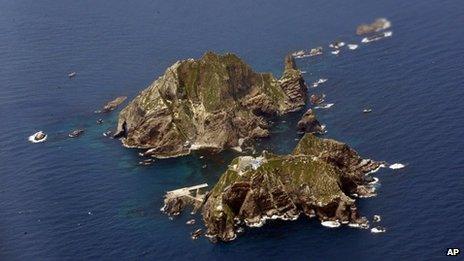Profile: Dokdo/Takeshima islands
- Published

The island grouping at the centre of a diplomatic dispute between South Korea and Japan is known by several names.
South Korea calls it Dokdo, which means solitary islands. Japan calls it Takeshima, which means bamboo islands. And it has also been known as the Liancourt Rocks, named by French whalers after their ship in 1849.
Both Japan and South Korea claim the islands, so too does North Korea.
The islands themselves consist of two main islands and about 30 smaller rocks. A South Korean coastguard detachment has been stationed there since 1954.
Both Japan and South Korea say they have long-standing historical ties to, and claims over, the island grouping.
South Korea says Dokdo was recognised by Japan as Korean territory in 1696, after a run-in between Korean and Japanese fishermen.
The island grouping was formally placed under the jurisdiction of Uldo county in 1900, it said, but annexed by Japan in 1905 ahead of its colonisation of the Korean peninsula.
Dokdo was rightly restored to Korea after World War II, it says. "Dokdo is an integral part of Korean territory historically, geographically and under international law," it says on a government website dedicated to the issue.
Dispute
But Japan's Foreign Ministry says on its website that Japan established sovereignty over the islands by the mid 17th Century, its sailors using it as a "navigational port, docking point for ships and a rich fishing ground".
It says it then incorporated the islands into modern-day Shimane prefecture in 1905. South Korea acted illegally by declaring them its territory in 1952, it says, because they were not included in territory to be returned under the San Francisco Peace Treaty.
"The occupation of Takeshima by the ROK (South Korea) is an illegal occupation undertaken on no basis of international law," the ministry of foreign affairs says.
There have been sporadic flare-ups over the issue, which remains a sore spot for both nations.
The islands are in good fishing grounds and it is thought that gas reserves may also lie nearby, although their amount is not clear.
But the islands also symbolise the lingering historical grievances between the two nations, which have their roots in Japan's lengthy colonisation of Korea.
In 2005, Japan's Shimane prefecture set up a dedicated "Takeshima Day", prompting strong protests from South Korea.
The issue flared again in 2008 amid a row over content in a Japanese teaching guide.
And as recently as July 2012, Japan filed a formal diplomatic protest with South Korea after a man rammed his truck against the gate of its embassy in Seoul to protest against Japan's claim to the islands.